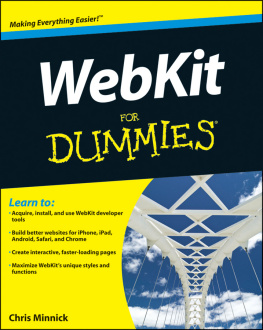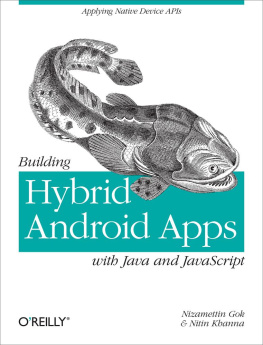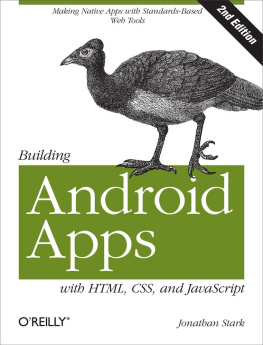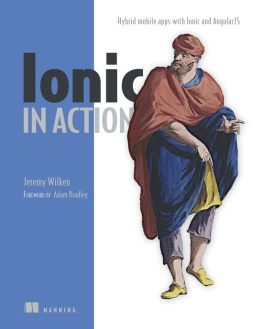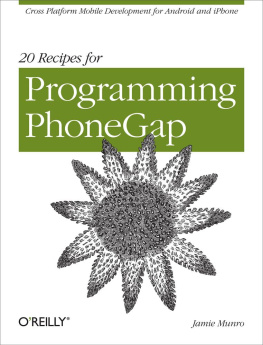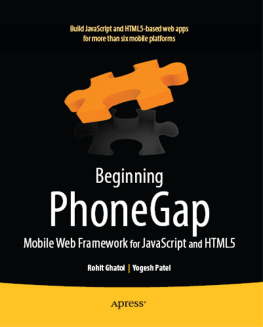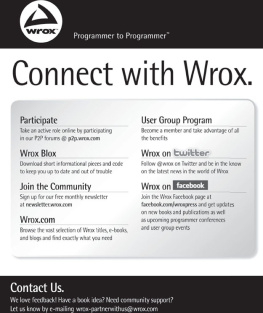Building iPhone Apps with HTML, CSS, and JavaScript
Jonathan Stark
Beijing Cambridge Farnham Kln Sebastopol Tokyo
Dedication
To Ericaand that little jumping bean in her tummy.
Special Upgrade Offer
If you purchased this ebook directly from oreilly.com, you have the following benefits:
DRM-free ebooksuse your ebooks across devices without restrictions or limitations
Multiple formatsuse on your laptop, tablet, or phone
Lifetime access, with free updates
Dropbox syncingyour files, anywhere
If you purchased this ebook from another retailer, you can upgrade your ebook to take advantage of all these benefits for just $4.99. to access your ebook upgrade.
Please note that upgrade offers are not available from sample content.
A Note Regarding Supplemental Files
Supplemental files and examples for this book can be found at http://examples.oreilly.com/9780596805791/. Please use a standard desktop web browser to access these files, as they may not be accessible from all ereader devices.
All code files or examples referenced in the book will be available online. For physical books that ship with an accompanying disc, whenever possible, weve posted all CD/DVD content. Note that while we provide as much of the media content as we are able via free download, we are sometimes limited by licensing restrictions. Please direct any questions or concerns to .
Preface
Like millions of people, I fell in love with my iPhone immediately. Initially, web apps were the only way to get a custom app on the device, which was fine by me because Im a web developer. Months later when the App Store was announced, I was jacked. I ran out and bought every Objective-C book on the market. Some of my web apps were already somewhat popular, and I figured Id just rewrite them as native apps, put them in the App Store, and ride off into the sunset on a big, galloping pile of money.
Disillusionment followed. I found it difficult to learn Objective-C, and I was turned off by the fact that the language was of little use outside of Mac programming. Xcode and Interface Builder were pretty slick, but they werent my normal authoring environment and I found them hard to get accustomed to. I was infuriated by the hoops I had to jump through just to set up my app and iPhone for testing. The process of getting the app into the App Store was even more byzantine. After a week or two of struggling with these variables, I found myself wondering why I was going to all the trouble. After all, my web apps were already available worldwidewhy did I care about being in the App Store?
On top of all this, Apple canand doesreject apps. This is certainly their prerogative, and maybe they have good reasons. However, from the outside, it seems capricious and arbitrary. Put yourself in these shoes (based on a true story, BTW): you spend about 100 hours learning Objective-C. You spend another 100 hours or so writing a native iPhone app. Eventually, your app is ready for prime time and you successfully navigate the gauntlet that is the App Store submission process. What happens next?
You wait. And wait. And wait some more. We are talking weeks, and sometimes months. Finally you hear back! And...your app is rejected. Now what? You have nothing to show for your effort. The bubble.
But wait, it can get worse. Lets say you do get your app approved. Hundreds or maybe thousands of people download your app. You havent received any money yet, but you are on cloud nine. Then, the bug reports start coming in. You locate and fix the bug in minutes, resubmit your app to iTunes, and wait for Apple to approve the revision. And wait. And wait some more. Angry customers are giving you horrible reviews in the App Store. Your sales are tanking. And still you wait. You consider offering a refund to the angry customers, but theres no way to do that through the App Store. So you are basically forced to sit there watching your ratings crash even though the bug was fixed days or weeks ago.
Sure, this story is based on the experience of one developer. Maybe its an edge case and the actual data doesnt bear out my thesis. But the problem remains: we developers have no access to Apples data, or the real details of the App Store approval process. Until that changes, building a native app with Objective-C is a risky proposition.
Fortunately, there is an alternative. You can build a web app using open source, standards-based web technologies, release it as a web app, and debug and test it under load with real users. Once you are ready to rock, you can use PhoneGap to convert your web app to a native iPhone app and submit it to the App Store. If its ultimately rejected, you arent dead in your tracks because you can still offer the web app. If its approved, great! You can then start adding features that enhance your web app by taking advantage of the unique hardware features available on the device. Sounds like the best of both worlds, right?
Who Should Read This Book
, so a passing familiarity with SQL syntax would be helpful but is not required.
What You Need to Use This Book
, where I explain how to convert your web app into a native app that you can submit to the App Store.
Conventions Used in This Book
The following typographical conventions are used in this book:
ItalicIndicates new terms, URLs, email addresses, filenames, and file extensions.
Constant widthUsed for program listings, as well as within paragraphs to refer to program elements such as variable or function names, databases, data types, environment variables, statements, and keywords.
Constant width boldShows commands or other text that should be typed literally by the user and for emphasis within code listings.
Constant width italicShows text that should be replaced with user-supplied values or by values determined by context.
Tip
This icon signifies a tip, suggestion, or general note.
Caution
This icon indicates a warning or caution.
Using Code Examples
This book is here to help you get your job done. In general, you may use the code in this book in your programs and documentation. You do not need to contact us for permission unless youre reproducing a significant portion of the code. For example, writing a program that uses several chunks of code from this book does not require permission. Selling or distributing a CD-ROM of examples from OReilly books does require permission. Answering a question by citing this book and quoting example code does not require permission. Incorporating a significant amount of example code from this book into your products documentation does require permission.
We appreciate, but do not require, attribution. An attribution usually includes the title, author, publisher, and ISBN. For example: Building iPhone Apps with HTML, CSS, and JavaScript by Jonathan Stark. Copyright 2010 Jonathan Stark, 978-0-596-80578-4.
.
Safari Books Online
Note
Safari Books Online is an on-demand digital library that lets you easily search over 7,500 technology and creative reference books and videos to find the answers you need quickly.
With a subscription, you can read any page and watch any video from our library online. Read books on your cell phone and mobile devices. Access new titles before they are available for print, and get exclusive access to manuscripts in development and post feedback for the authors. Copy and paste code samples, organize your favorites, download chapters, bookmark key sections, create notes, print out pages, and benefit from tons of other time-saving features.



